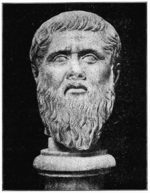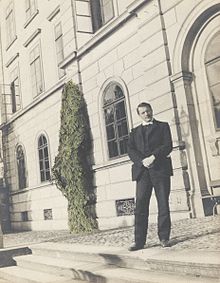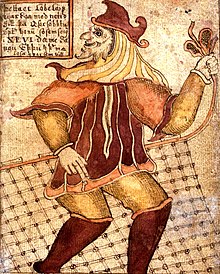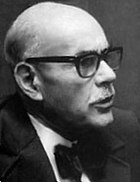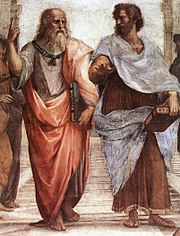In theory, Jungian archetypes refer to unclear underlying forms or the archetypes-as-such from which emerge images and motifs such as the mother, the child, the trickster, and the flood
among others. History, culture and personal context shape these
manifest representations thereby giving them their specific content.
These images and motifs are more precisely called archetypal images. However it is common for the term archetype to be used interchangeably to refer to both archetypes-as-such and archetypal images.
Introduction
Jung's ideas on archetypes were based in part on Plato's Forms.
Jung rejected the tabula rasa
theory of human psychological development, believing instead that
evolutionary pressures have individual predestinations manifested in
archetypes. Jung first used the term primordial images to refer to what he would later term "archetypes". Jung's idea of archetypes was based on Immanuel Kant's categories, Plato's Ideas, and Arthur Schopenhauer's prototypes. For Jung, "the archetype is the introspectively recognizable form of a priori psychic orderedness".
"These images must be thought of as lacking in solid content, hence as
unconscious. They only acquire solidity, influence, and eventual
consciousness in the encounter with empirical facts."
The archetypes form a dynamic substratum common to all humanity,
upon the foundation of which each individual builds his own experience
of life, colouring them with his unique culture, personality and life
events. Thus, while archetypes themselves may be conceived as a relative
few innate nebulous forms, from these may arise innumerable images,
symbols and patterns of behavior. While the emerging images and forms
are apprehended consciously, the archetypes which inform them are
elementary structures which are unconscious and impossible to apprehend.
Jung was fond of comparing the form of the archetype to the axial
system of a crystal, which preforms the crystalline structure of the
mother liquid, although it has no material existence of its own. This
first appears according to the specific way in which the ions and
molecules aggregate. The archetype in itself is empty and purely formal:
a possibility of representation which is given a priori. The
representations themselves are not inherited, only the forms, and in
that respect they correspond to the instincts. The existence of the
instincts can no more be proved than the existence of the archetypes, so
long as they do not manifest themselves concretely.
Early development
Carl Jung standing in front of Burghölzli clinic, Zurich 1909
The intuition that there was more to the psyche than individual
experience possibly began in Jung's childhood. The very first dream he
could remember was that of an underground phallic god. Later in life his research on psychotic
patients in Burgholzli Hospital and his own self-analysis later
supported his early intuition about the existence of universal psychic
structures that underlie all human experience and behavior. Jung first
referred to these as "primordial images" – a term he borrowed from Jacob Burckhardt. Later in 1917 Jung called them "dominants of the collective unconscious."
It was not until 1919 that he first used the term "archetypes"
in an essay titled "Instinct and the Unconscious". The first element in
Greek 'arche' signifies 'beginning, origin, cause, primal source
principle', but it also signifies 'position of a leader, supreme rule
and government' (in other words a kind of 'dominant'): the second
element 'type' means 'blow and what is produced by a blow, the imprint
of a coin ...form, image, prototype, model, order, and norm', ...in the
figurative, modern sense, 'pattern underlying form, primordial form'.
Later development
In
later years Jung revised and broadened the concept of archetypes even
further, conceiving of them as psycho-physical patterns existing in the
universe, given specific expression by human consciousness and culture.
Jung proposed that the archetype had a dual nature: it exists both in
the psyche and in the world at large. He called this non-psychic aspect
of the archetype the "psychoid" archetype.
The analogy illustrated by Jung
Jung drew an analogy between the psyche and light on the electromagnetic spectrum.
The center of the visible light spectrum (i.e., yellow) corresponds to
consciousness, which grades into unconsciousnessness at the red and blue
ends. Red corresponds to basic unconscious urges, and the invisible
infra-red end of the spectrum corresponds to the influence of biological
instinct,
which merges with its chemical and physical conditions. The blue end of
the spectrum represents spiritual ideas; and the archetypes, exerting
their influence from beyond the visible, correspond to the invisible
realm of ultra-violet.
Jung suggested that not only do the archetypal structures govern the
behavior of all living organisms, but that they were contiguous with
structures controlling the behavior of inorganic matter as well.
The archetype was not merely a psychic entity, but more fundamentally, a bridge to matter in general. Jung used the term unus mundus to describe the unitary reality which he believed underlay all manifest phenomena. He conceived archetypes to be the mediators of the unus mundus, organizing not only ideas in the psyche, but also the fundamental principles of matter and energy in the physical world.
It was this psychoid aspect of the archetype that so impressed Nobel laureate physicist Wolfgang Pauli. Embracing Jung's concept, Pauli believed that the archetype provided a link between physical events and the mind of the scientist who studied them. In doing so he echoed the position adopted by German astronomer Johannes Kepler.
Thus the archetypes that ordered our perceptions and ideas are
themselves the product of an objective order that transcends both the
human mind and the external world.
Examples
The Norse trickster god Loki as depicted on an 18th-century Icelandic manuscript
Jung described archetypal events: birth, death, separation from parents, initiation, marriage, the union of opposites; archetypal figures: great mother, father, child, devil, god, wise old man, wise old woman, the trickster, the hero; and archetypal motifs:
the apocalypse, the deluge, the creation. Although the number of
archetypes is limitless, there are a few particularly notable, recurring
archetypal images, "the chief among them being" (according to Jung)
"the shadow, the wise old man, the child, the mother ... and her counterpart, the maiden, and lastly the anima in man and the animus in woman".
Alternatively he would speak of "the emergence of certain definite
archetypes ... the shadow, the animal, the wise old man, the anima, the
animus, the mother, the child".
The Self designates the whole range of psychic phenomena in man. It expresses the unity of the personality as a whole.
The shadow
is a representation of the personal unconscious as a whole and usually
embodies the compensating values to those held by the conscious
personality. Thus, the shadow often represents one's dark side, those
aspects of oneself that exist, but which one does not acknowledge or
with which one does not identify.
The anima
archetype appears in men and is his primordial image of woman. It
represents the man's sexual expectation of women, but also is a symbol
of a man's possibilities, his contrasexual tendencies. The animus archetype is the analogous image of the masculine that occurs in women.
Any attempt to give an exhaustive list of the archetypes,
however, would be a largely futile exercise since the archetypes tend to
combine with each other and interchange qualities making it difficult
to decide where one archetype stops and another begins. For example,
qualities of the shadow archetype may be prominent in an archetypal
image of the anima or animus. One archetype may also appear in various
distinct forms, thus raising the question whether four or five distinct
archetypes should be said to be present or merely four or five forms of a
single archetype.
Conceptual difficulties
Strictly speaking the goddess archetype is more properly called an archetypal image
Popular and new-age uses have often condensed the concept of
archetypes into an enumeration of archetypal figures such as the hero,
the goddess, the wise man and so on. Such enumeration falls short of
apprehending the fluid core concept. Strictly speaking, archetypal
figures such as the hero, the goddess and the wise man are not
archetypes, but archetypal images which have crystallized out of the archetypes-as-such:
as Jung put it, "definite mythological images of motifs ... are nothing
more than conscious representations; it would be absurd to assume that
such variable representations could be inherited", as opposed to their
deeper, instinctual sources – "the 'archaic remnants', which I call
'archetypes' or 'primordial images'".
However, the precise relationships between images such as, for
example, "the fish" and its archetype were not adequately explained by
Jung. Here the image of the fish is not strictly speaking an archetype.
The "archetype of the fish" points to the ubiquitous existence of an
innate "fish archetype" which gives rise to the fish image. In
clarifying the contentious statement that fish archetypes are universal,
Anthony Stevens explains that the archetype-as-such
is at once an innate predisposition to form such an image and a
preparation to encounter and respond appropriately to the creature per se.
This would explain the existence of snake and spider phobias, for
example, in people living in urban environments where they have never
encountered either creature.
The confusion about the essential quality of archetypes can
partly be attributed to Jung's own evolving ideas about them in his
writings and his interchangeable use of the term "archetype" and
"primordial image". Jung was also intent on retaining the raw and vital
quality of archetypes as spontaneous outpourings of the unconscious and
not to give their specific individual and cultural expressions a dry,
rigorous, intellectually formulated meaning.
Actualization and complexes
Archetypes seek actualization within the context of an individual's environment and determine the degree of individuation.
Jung also used the terms "evocation" and "constellation" to explain the
process of actualization. Thus for example, the mother archetype is
actualized in the mind of the child by the evoking of innate
anticipations of the maternal archetype when the child is in the
proximity of a maternal figure who corresponds closely enough to its
archetypal template. This mother archetype is built into the personal
unconscious of the child as a mother complex. Complexes are
functional units of the personal unconscious, in the same way that
archetypes are units for the collective unconscious.
Stages of life
An initiation ceremony in Papua New Guinea
Archetypes are innate universal pre-conscious psychic dispositions
that form the substrate from which the basic themes of human life
emerge. The archetypes are components of the collective unconscious and serve to organize, direct and inform human thought and behaviour. Archetypes hold control of the human life cycle.
As we mature the archetypal plan unfolds through a programmed
sequence which Jung called the stages of life. Each stage of life is
mediated through a new set of archetypal imperatives which seek
fulfillment in action. These may include being parented, initiation,
courtship, marriage and preparation for death.
"The archetype is a tendency to form such representations of a
motif – representations that can vary a great deal in detail without
losing their basic pattern ... They are indeed an instinctive trend". Thus, "the archetype of initiation is strongly activated to provide a meaningful transition ... with a 'rite of passage' from one stage of life to the next": such stages may include being parented, initiation, courtship, marriage and preparation for death.
General developments
Claude Lévi-Strauss was an advocate of structuralism in anthropology.
In his approach to the structure and meaning of myth, Levi-Strauss
concluded that present phenomena are transformations of earlier
structures or infrastructures: 'the structure of primitive thoughts is
present in our minds'.
The concept of "social instincts" proposed by Charles Darwin, the "faculties" of Henri Bergson and the isomorphs of gestalt psychologist Wolfgang Kohler are also arguably related to archetypes.
In his work in psycholinguistics, Noam Chomsky describes an unvarying pattern of language acquisition in children and termed it the language acquisition device.
He refers to 'universals' and a distinction is drawn between 'formal'
and 'substantive' universals similar to that between archetype as such
(structure) and archetypal image.
Jean Piaget
writes of 'schemata' which are innate and underpin perceptuo-motor
activity and the acquisition of knowledge, and are able to draw the
perceived environment into their orbit. They resemble archetypes by
virtue of their innateness, their activity and their need for
environmental correspondence.
Ethology and attachment theory
In Biological theory and the concept of archetypes, Michael Fordham
considered that innate release mechanisms in animals may be applicable
to humans, especially in infancy. The stimuli which produce instinctive
behaviour are selected from a wide field by an innate perceptual system
and the behaviour is 'released'. Fordham drew a parallel between some of
Lorenz's ethological observations on the hierarchical behaviour of
wolves and the functioning of archetypes in infancy.
Stevens (1982) suggests that ethology and analytical psychology
are both disciplines trying to comprehend universal phenomena. Ethology
shows us that each species is equipped with unique behavioural
capacities that are adapted to its environment and 'even allowing for
our greater adaptive flexibility, we are no exception. Archetypes are
the neuropsychic centres responsible for co-ordinating the behavioural
and psychic repertoire of our species'. Following Bowlby, Stevens points
out that genetically programmed behaviour is taking place in the
psychological relationship between mother and newborn. The baby's
helplessness, its immense repertoire of sign stimuli and approach
behaviour, triggers a maternal response. And the smell, sound and shape
of mother triggers, for instance, a feeding response.
Biology
Stevens
suggests that DNA itself can be inspected for the location and
transmission of archetypes. As they are co-terminous with natural life
they should be expected wherever life is found. He suggests that DNA is
the replicable archetype of the species.
Stein points out that all the various terms used to delineate the
messengers – 'templates, genes, enzymes, hormones, catalysts,
pheromones, social hormones' – are concepts similar to archetypes. He
mentions archetypal figures which represent messengers such as Hermes,
Prometheus or Christ. Continuing to base his arguments on a
consideration of biological defence systems he says that it must operate
in a whole range of specific circumstances, its agents must be able to
go everywhere, the distribution of the agents must not upset the somatic
status quo, and, in predisposed persons, the agents will attack the
self.
Psychoanalysis
Melanie Klein
Melanie Klein: Melanie Klein's idea of unconscious phantasy is closely related to Jung's archetype, as both are composed of image and affect and are a priori patternings of psyche whose contents are built from experience.
Jacques Lacan:
Lacan went beyond the proposition that the unconscious is a structure
that lies beneath the conscious world; the unconscious itself is
structured, like a language. This would suggest parallels with Jung.
Further Lacan's Symbolic and Imaginary orders may be aligned with Jung's
archetypal theory and personal unconscious respectively. The Symbolic
order patterns the contents of the Imaginary in the same way that
archetypal structures predispose humans towards certain sorts of
experience. If we take the example of parents, archetypal structures and
the Symbolic order predispose our recognition of, and relation to them.
Lacan's concept of the Real approaches Jung's elaboration of the
psychoid unconscious, which may be seen as true but cannot be directly
known. Lacan posited that the unconscious is organised in an intricate
network governed by association, above all 'metaphoric associations'.
The existence of the network is shown by analysis of the unconscious
products: dreams, symptoms, and so on.
Wilfred Bion
Wilfred Bion:
According to Bion, thoughts precede a thinking capacity. Thoughts in a
small infant are indistinguishable from sensory data or unorganised
emotion. Bion uses the term proto-thoughts for these early phenomena.
Because of their connection to sensory data, proto-thoughts are concrete
and self-contained (thoughts-in-themselves), not yet capable of
symbolic representations or object relations. The thoughts then function
as preconceptions – predisposing psychosomatic entities similar to
archetypes. Support for this connection comes from the Kleinian analyst
Money-Kyrle's observation that Bion's notion of preconceptions is the
direct descendant of Plato's Ideas.
Sigmund Freud
Sigmund Freud: In the Introductory Lectures on Psychoanalysis
(1916-1917) Freud wrote: "There can be no doubt that the source [of the
fantasies] lie in the instincts; but it still has to be explained why
the same fantasies with the same content are created on every occasion. I
am prepared with an answer that I know will seem daring to you. I
believe that...primal fantasies, and no doubt a few others as well, are a
phylogenetic
endowment". His suggestion that primal fantasies are a residue of
specific memories of prehistoric experiences have been construed as
being aligned with the idea of archetypes. Laplanehe and Pontalis point
out that all the so-called primal fantasies relate to the origins and
that "like collective myths they claim to provide a representation of
and a 'solution' to whatever constitutes an enigma for the child".
Robert Langs:
More recently, adaptive psychotherapist and psychoanalyst Robert Langs
has used archetypal theory as a way of understanding the functioning of
what he calls the "deep unconscious system". Langs' use of archetypes particularly pertains to issues associated with death anxiety,
which Langs takes to be the root of psychic conflict. Like Jung, Langs
thinks of archetypes as species-wide, deep unconscious factors.
Neurology
Rossi
(1977) suggests that the function and characteristic between left and
right cerebral hemispheres may enable us to locate the archetypes in the
right cerebral hemisphere. He cites research indicating that left
hemispherical functioning is primarily verbal and associational, and
that of the right primarily visuospatial and apperceptive. Thus the left
hemisphere is equipped as a critical, analytical, information processor
while the right hemisphere operates in a 'gestalt' mode. This means
that the right hemisphere is better at getting a picture of a whole from
a fragment, is better at working with confused material, is more
irrational than the left, and more closely connected to bodily
processes. Once expressed in the form of words, concepts and language of
the ego's left hemispheric realm, however, they become only
representations that 'take their colour' from the individual
consciousness. Inner figures such as shadow, anima and animus would be
archetypal processes having source in the right hemisphere.
Henry (1977) alluded to Maclean's model of the tripartite brain
suggesting that the reptilian brain is an older part of the brain and
may contain not only drives but archetypal structures as well. The
suggestion is that there was a time when emotional behaviour and
cognition were less developed and the older brain predominated. There is
an obvious parallel with Jung's idea of the archetypes 'crystallising
out' over time.
Literary criticism
Archetypal literary criticism
argues that archetypes determine the form and function of literary
works, and therefore, that a text's meaning is shaped by cultural and
psychological myths. Archetypes are the unknowable basic forms
personified or concretized in recurring images, symbols, or patterns
which may include motifs such as the quest or the heavenly ascent,
recognizable character types such as the trickster or the hero, symbols
such as the apple or snake, or images such as crucifixion (as in King
Kong, or Bride of Frankenstein) are all already laden with meaning when
employed in a particular work.
Psychology
Archetypal psychology was developed by James Hillman
in the second half of the 20th century. Hillman trained at the Jung
Institute and was its Director after graduation. Archetypal psychology
is in the Jungian tradition and most directly related to analytical psychology and psychodynamic theory, yet departs radically. Archetypal psychology relativizes and deliteralizes the ego and focuses on the psyche, or soul, itself and the archai, the deepest patterns of psychic functioning, "the fundamental fantasies that animate all life". Archetypal psychology is a polytheistic psychology, in that it attempts to recognize the myriad fantasies and myths, gods, goddesses, demigods, mortals and animals – that shape and are shaped by our psychological lives. The ego is but one psychological fantasy within an assemblage of fantasies.
The main influence on the development of archetypal psychology is
Jung's analytical psychology. It is strongly influenced by Classical Greek, Renaissance,
and Romantic ideas and thought. Influential artists, poets,
philosophers, alchemists, and psychologists include: Nietzsche, Henry
Corbin, Keats, Shelley, Petrarch, and Paracelsus. Though all different
in their theories and psychologies, they appear to be unified by their
common concern for the psyche – the soul.
Many archetypes have been used in treatment of psychological illnesses.
Jung's first research was done with schizophrenics. A current
example is teaching young men or boys archetypes through using picture
books to help with the development. In addition nurses treat patients through the use of archetypes.
Archetype therapy offers a wide range of uses if applied correctly, and
it is still being expanded in Jungian schools today. With the list of
archetypes being endless the healing possibilities are vast.
Pedagogy
Archetypal pedagogy was developed by Clifford Mayes. Mayes' work also aims at promoting what he calls archetypal reflectivity in teachers; this is a means of encouraging teachers to examine and work with psychodynamic issues, images, and assumptions as those factors affect their pedagogical practices. More recently the Pearson-Marr Archetype Indicator
(PMAI), based on Jung's theories of both archetypes and personality
types, has been used for pedagogical applications (not unlike the Myers–Briggs Type Indicator).
In popular culture
Archetypes
abound in contemporary films and literature as they have in creative
works of the past, being unconscious projections of the collective
unconscious that serve to embody central societal and developmental
struggles in a media that entertain as well as instruct. Films are a
contemporary form of mythmaking, reflecting our response to ourselves
and the mysteries and wonders of our existence.
In national trauma
A
contemporary definition is given by O'Brien (2017) as follows:
"Archetypes are universal organizing themes or patterns that appear
regardless of space, time, or person. Appearing in all existential
realms and at all levels of systematic recursion, they are organized as
themes in the unus mundus, which Jung (1970 Vol. 14. Mysterium
coniunctionis. (1970), p. 505) described as “the potential world outside
of time,” and are detectable through synchronicities".
Contemporary cinema is a rich source of archetypal images, most
commonly evidenced for instance in the hero archetype: the one who saves
the day and is young and inexperienced, like Luke Skywalker in Star Wars, or older and cynical, like Rick Blaine in Casablanca.
The mentor archetype is a common character in all types of films. They
can appear and disappear as needed, usually helping the hero in the
beginning, and then letting them do the hard part on their own. The
mentor helps train, prepare, encourage and guide the hero. They are
obvious in some films: Mr. Miyagi in The Karate Kid, Gandalf in The Lord of the Rings, Jiminy Cricket in Pinocchio, Obi-Wan, and later Yoda in the original Star Wars trilogy.
The Shadow, one's darker side, often associated with the villain of numerous films and books, but can be internal as in Dr. Jekyll and Mr. Hyde.
The shapeshifter is the person who misleads the hero or who changes
frequently and can be depicted quite literally e.g. The T-1000 robot in Terminator II.
The Trickster creates disruptions of the status quo, maybe childlike
and help us see the absurdity in situations, provide comic relief; e.g. Yoda in The Empire Strikes Back, Bugs Bunny and Brer Rabbit.
The Child often innocent; could be someone childlike who needs
protecting but may be imbued with special powers (e.g. E.T.). The Bad
Father – often seen as a dictator type, or evil and cruel (e.g. Darth
Vader in Star Wars). The Bad Mother (e.g. Mommie Dearest), along with evil stepmothers and wicked witches. The Bad Child; e.g., The Bad Seed, The Omen.
Jungian archetypes are heavily integrated into the personalities of the characters in the Persona series of games. In Persona 3 and Persona 4,
the characters with whom you form relationships, (in the game called
"Social Links") which are each based on a particular archetype. They are
formally differentiated by different tarot arcana, however the primary basis of the game's characterization originates from archetypes.
In marketing, an archetype is a genre to a brand, based upon
symbolism. The idea behind using brand archetypes in marketing is to
anchor the brand against an icon already embedded within the conscience
and subconscious of humanity. In the minds of both the brand owner and
the public, aligning with a brand archetype makes the brand easier to
identify. Twelve archetypes have been proposed for use with branding:
Sage, Innocent, Explorer, Ruler, Creator, Caregiver, Magician, Hero,
Outlaw, Lover, Jester, and Regular Person.
Criticism
Jung's staunchest critics have accused him of either mystical or metaphysical essentialism.
Since archetypes are defined so vaguely and since archetypal images
have been observed by many Jungians in a wide and essentially infinite
variety of everyday phenomena, they are neither generalizable nor
specific in a way that may be researched or demarcated with any kind of
rigor. Hence they elude systematic study. Jung and his supporters
defended the impossibility of providing rigorous operationalised
definitions as a problem peculiar not only to archetypal psychology
alone, but also other domains of knowledge that seek to understand
complex systems in an integrated manner.
Feminist critiques have focused on aspects of archetypal theory
that are seen as being reductionistic and providing a stereotyped view
of femininity and masculinity.
Another criticism of archetypes is that seeing myths as
universals tends to abstract them from the history of their actual
creation, and their cultural context.
Some modern critics state that archetypes reduce cultural expressions
to generic decontextualized concepts, stripped bare of their unique
cultural context, reducing a complex reality into something "simple and
easy to grasp".
Other critics respond that archetypes do nothing more than to solidify
the cultural prejudices of the myths interpreter – namely modern
Westerners. Modern scholarship with its emphasis on power and politics
have seen archetypes as a colonial device to level the specifics of
individual cultures and their stories in the service of grand
abstraction.
Others have accused him of a romanticised and prejudicial
promotion of 'primitivism' through the medium of archetypal theory.
Archetypal theory has been posited as being scientifically unfalsifiable
and even questioned as to being a suitable domain of psychological and
scientific enquiry. Jung mentions the demarcation between experimental
and descriptive psychological study, seeing archetypal psychology as
rooted by necessity in the latter camp, grounded as it was (to a degree)
in clinical case-work.
Because Jung's viewpoint was essentially subjectivist, he
displayed a somewhat Neo-Kantian perspective of a skepticism for knowing
things in themselves and a preference of inner experience over
empirical data. This skepticism opened Jung up to the charge of
countering materialism with another kind of reductionism, one that
reduces everything to subjective psychological explanation and wooly
quasi-mystical assertions.
Post-Jungian criticism seeks to contextualise, expand and modify
Jung's original discourse on archetypes. Michael Fordham is critical of
tendencies to relate imagery produced by patients to historical
parallels only, e.g. from alchemy, mythology or folklore. A patient who
produces archetypal material with striking alchemical parallels runs the
risk of becoming more divorced than before from his setting in
contemporary life.
